Management Accounting Assignment - Finance Module Analysis
VerifiedAdded on 2020/03/28
|16
|1601
|93
Homework Assignment
AI Summary
This document presents a comprehensive solution to a management accounting assignment, addressing key concepts such as process costing, equivalent units, joint production costs, and variance analysis. The assignment explores the application of these concepts through several questions, including a comparison of cost management techniques in the context of the Great Pyramid of Giza and a detailed analysis of cost allocation and profit calculations. The solution includes calculations for equivalent units, cost per unit, and variance analysis, as well as discussions on budgeting and political factors influencing financial planning. The document also covers the impact of selling prices and the importance of variance analysis in business management.
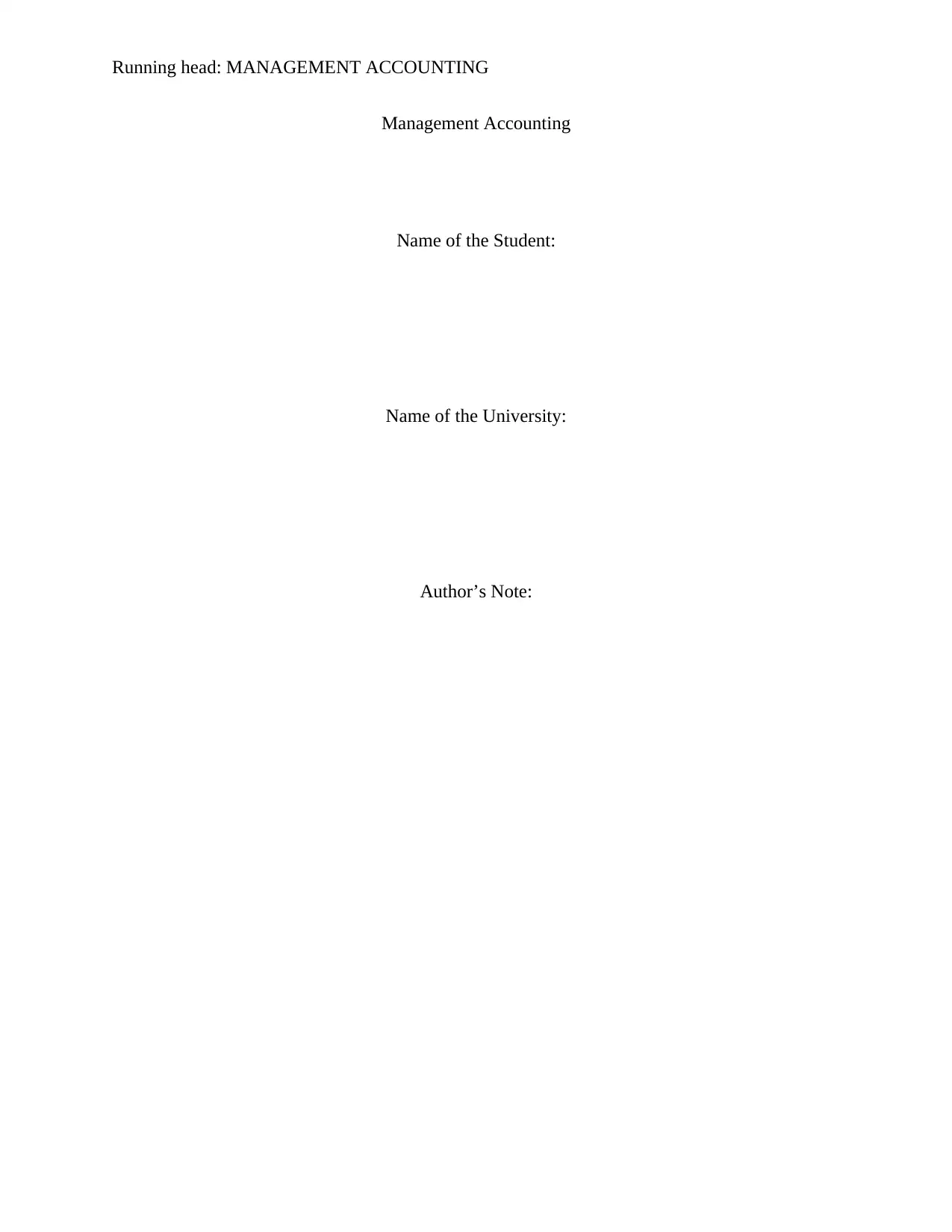
Running head: MANAGEMENT ACCOUNTING
Management Accounting
Name of the Student:
Name of the University:
Author’s Note:
Management Accounting
Name of the Student:
Name of the University:
Author’s Note:
Paraphrase This Document
Need a fresh take? Get an instant paraphrase of this document with our AI Paraphraser
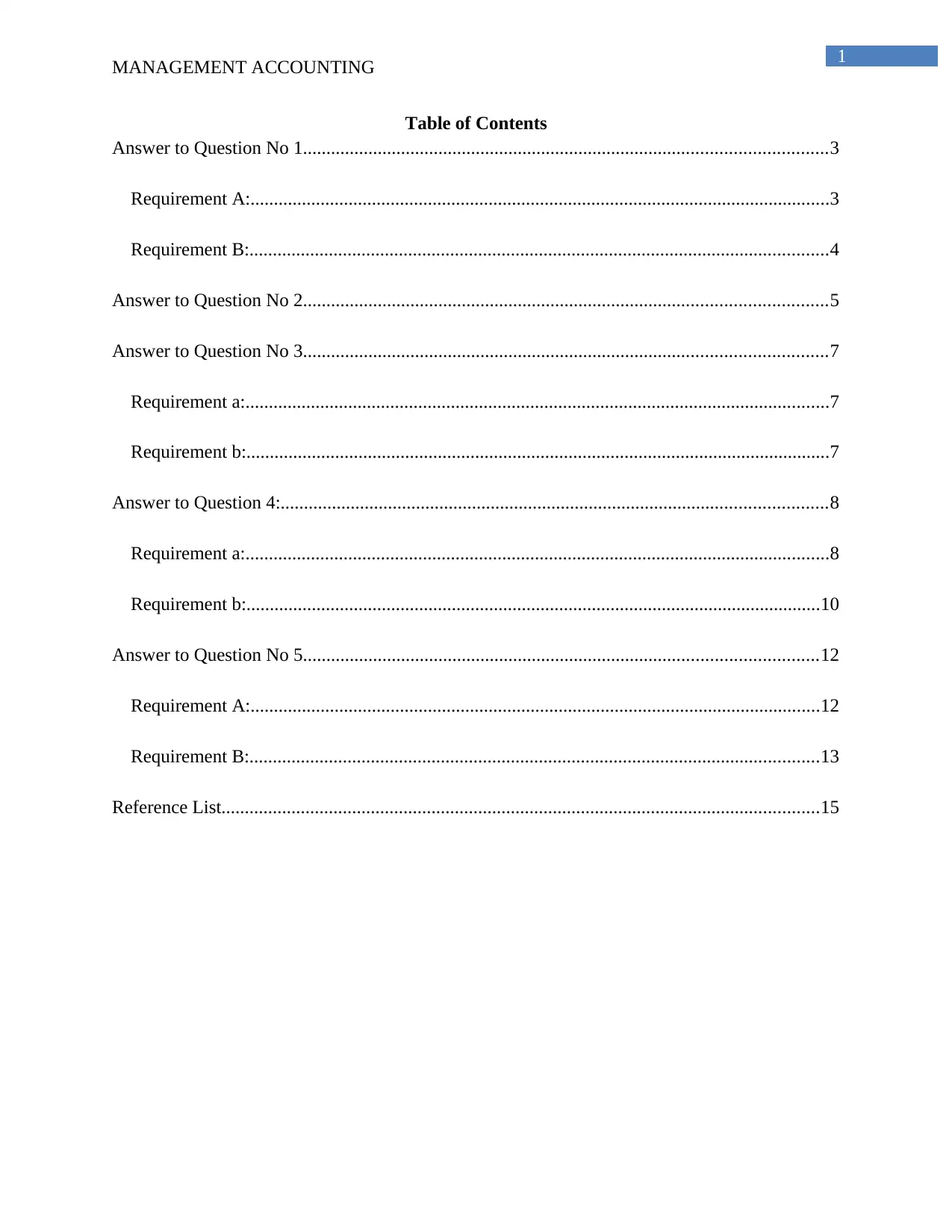
1
MANAGEMENT ACCOUNTING
Table of Contents
Answer to Question No 1................................................................................................................3
Requirement A:............................................................................................................................3
Requirement B:............................................................................................................................4
Answer to Question No 2................................................................................................................5
Answer to Question No 3................................................................................................................7
Requirement a:.............................................................................................................................7
Requirement b:.............................................................................................................................7
Answer to Question 4:.....................................................................................................................8
Requirement a:.............................................................................................................................8
Requirement b:...........................................................................................................................10
Answer to Question No 5..............................................................................................................12
Requirement A:..........................................................................................................................12
Requirement B:..........................................................................................................................13
Reference List................................................................................................................................15
MANAGEMENT ACCOUNTING
Table of Contents
Answer to Question No 1................................................................................................................3
Requirement A:............................................................................................................................3
Requirement B:............................................................................................................................4
Answer to Question No 2................................................................................................................5
Answer to Question No 3................................................................................................................7
Requirement a:.............................................................................................................................7
Requirement b:.............................................................................................................................7
Answer to Question 4:.....................................................................................................................8
Requirement a:.............................................................................................................................8
Requirement b:...........................................................................................................................10
Answer to Question No 5..............................................................................................................12
Requirement A:..........................................................................................................................12
Requirement B:..........................................................................................................................13
Reference List................................................................................................................................15
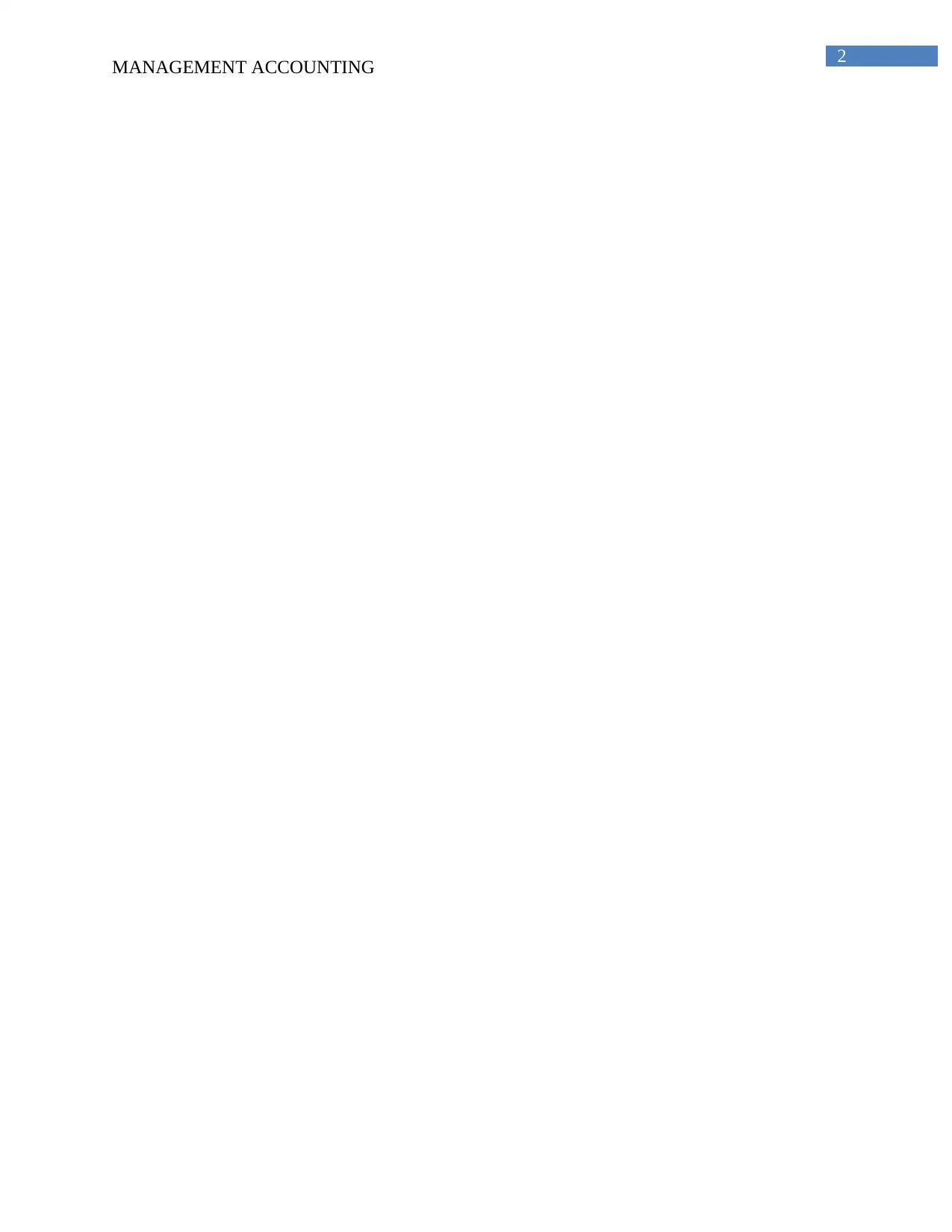
2
MANAGEMENT ACCOUNTING
MANAGEMENT ACCOUNTING
⊘ This is a preview!⊘
Do you want full access?
Subscribe today to unlock all pages.

Trusted by 1+ million students worldwide
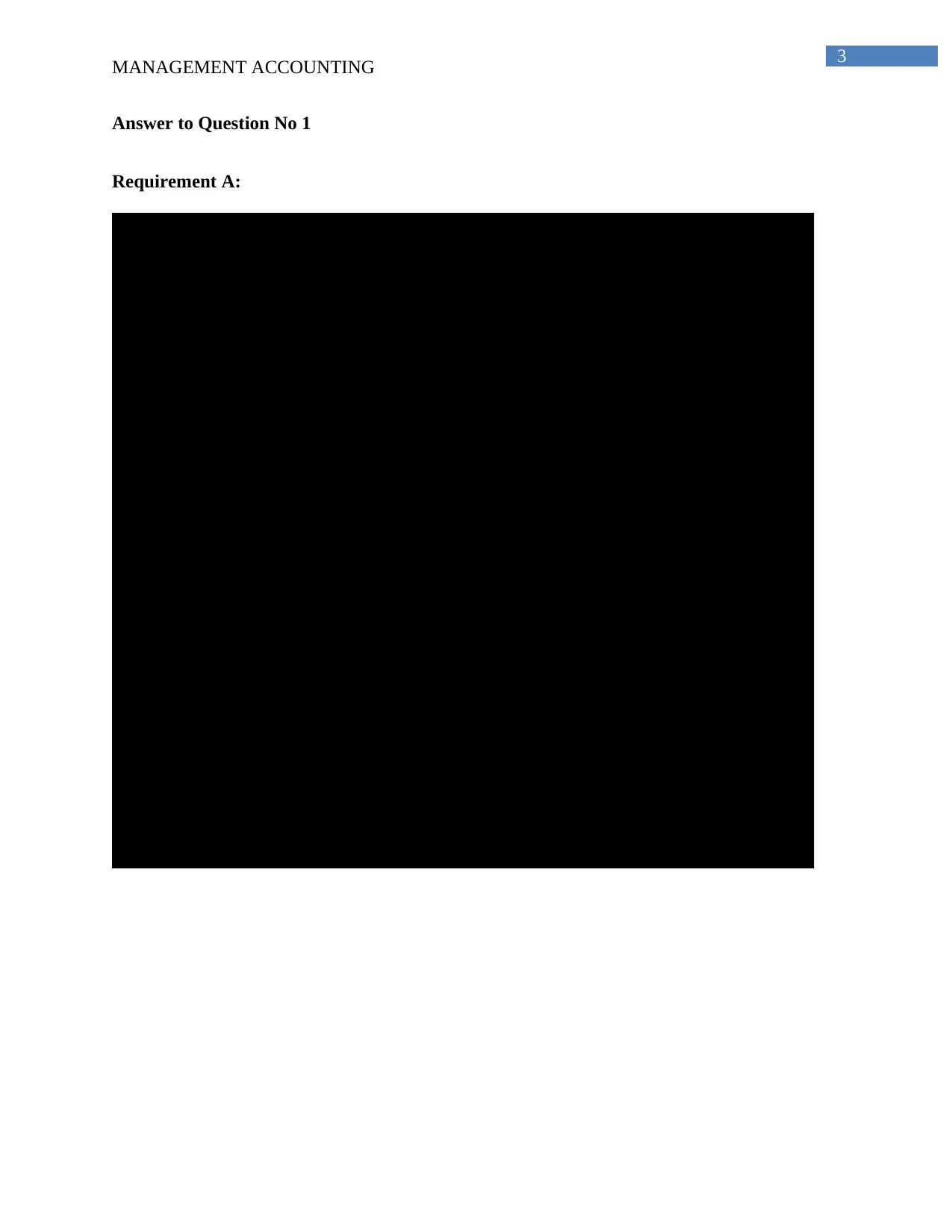
3
MANAGEMENT ACCOUNTING
Answer to Question No 1
Requirement A:
DR. CR.
Date Particulars Amount Date Particulars Amount
To, Balance b/d. 24855 31/8/14 By, Work-in-Process A/c. 6010
To, Accounts Payable A/c. 6155 By, Balance c/d 25000
31010 31010
DR. CR.
Date Particulars Amount Date Particulars Amount
1/8/X4 To, Balance b/d 8790 31/8/X4 By, Cost of Goods Sold A/c. 30000
31/8/X4 To, Work-in-Process A/c. 30110 By,Balance c/d 8900
38900 38900
DR. CR.
Date Particulars Amount Date Particulars Amount
31/8/X4 To, Finished Goods A/c. 30000 31/8/X4 By, Profit & Loss A/c. 32800
To, Manufacturing
Overhead A/c. 2800
32800 32800
Direct Material Account
Finished Goods
Cost of Goods Sold
MANAGEMENT ACCOUNTING
Answer to Question No 1
Requirement A:
DR. CR.
Date Particulars Amount Date Particulars Amount
To, Balance b/d. 24855 31/8/14 By, Work-in-Process A/c. 6010
To, Accounts Payable A/c. 6155 By, Balance c/d 25000
31010 31010
DR. CR.
Date Particulars Amount Date Particulars Amount
1/8/X4 To, Balance b/d 8790 31/8/X4 By, Cost of Goods Sold A/c. 30000
31/8/X4 To, Work-in-Process A/c. 30110 By,Balance c/d 8900
38900 38900
DR. CR.
Date Particulars Amount Date Particulars Amount
31/8/X4 To, Finished Goods A/c. 30000 31/8/X4 By, Profit & Loss A/c. 32800
To, Manufacturing
Overhead A/c. 2800
32800 32800
Direct Material Account
Finished Goods
Cost of Goods Sold
Paraphrase This Document
Need a fresh take? Get an instant paraphrase of this document with our AI Paraphraser
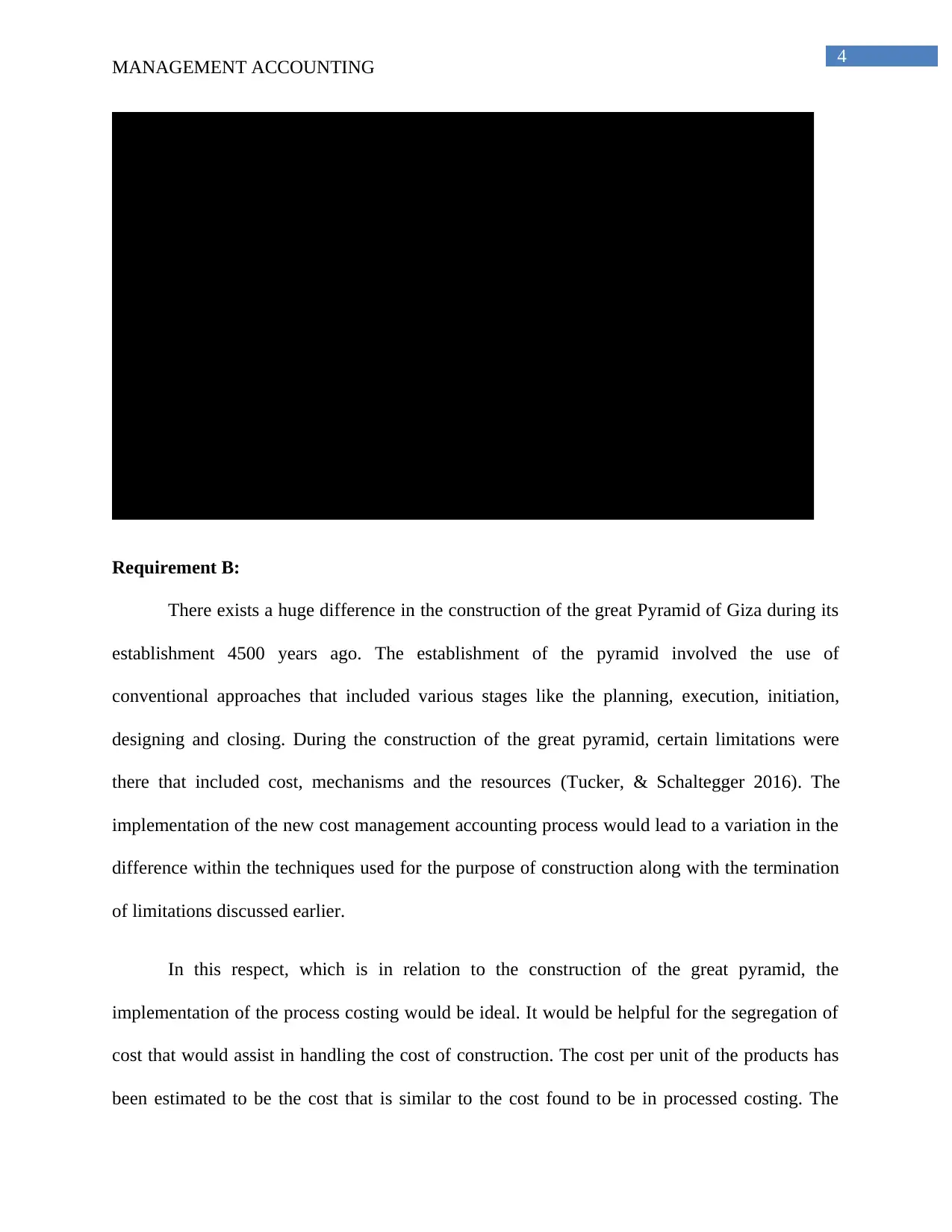
4
MANAGEMENT ACCOUNTING
DR. CR.
Date Particulars Amount Date Particulars Amount
1/8/X4 To, Balance b/d 6700 31/8/X4 By, Finished Goods A/c. 30110
To, Direct Labor A/c. 14800 By, Balance c/d 9400
To, Manufacturing Overhead A/c. 12000
To, Direct Material A/c. 6010
39510 39510
DR. CR.
Date Particulars Amount Date Particulars Amount
31/8/X4 To, Bank A/c. 6700 1/8/X4 By, Balance b/d 2345
31/8/X4 To, Balance c/d 1800 By, Direct Material A/c. 6155
8500 8500
Work-in-Process
Accounts Payable
Requirement B:
There exists a huge difference in the construction of the great Pyramid of Giza during its
establishment 4500 years ago. The establishment of the pyramid involved the use of
conventional approaches that included various stages like the planning, execution, initiation,
designing and closing. During the construction of the great pyramid, certain limitations were
there that included cost, mechanisms and the resources (Tucker, & Schaltegger 2016). The
implementation of the new cost management accounting process would lead to a variation in the
difference within the techniques used for the purpose of construction along with the termination
of limitations discussed earlier.
In this respect, which is in relation to the construction of the great pyramid, the
implementation of the process costing would be ideal. It would be helpful for the segregation of
cost that would assist in handling the cost of construction. The cost per unit of the products has
been estimated to be the cost that is similar to the cost found to be in processed costing. The
MANAGEMENT ACCOUNTING
DR. CR.
Date Particulars Amount Date Particulars Amount
1/8/X4 To, Balance b/d 6700 31/8/X4 By, Finished Goods A/c. 30110
To, Direct Labor A/c. 14800 By, Balance c/d 9400
To, Manufacturing Overhead A/c. 12000
To, Direct Material A/c. 6010
39510 39510
DR. CR.
Date Particulars Amount Date Particulars Amount
31/8/X4 To, Bank A/c. 6700 1/8/X4 By, Balance b/d 2345
31/8/X4 To, Balance c/d 1800 By, Direct Material A/c. 6155
8500 8500
Work-in-Process
Accounts Payable
Requirement B:
There exists a huge difference in the construction of the great Pyramid of Giza during its
establishment 4500 years ago. The establishment of the pyramid involved the use of
conventional approaches that included various stages like the planning, execution, initiation,
designing and closing. During the construction of the great pyramid, certain limitations were
there that included cost, mechanisms and the resources (Tucker, & Schaltegger 2016). The
implementation of the new cost management accounting process would lead to a variation in the
difference within the techniques used for the purpose of construction along with the termination
of limitations discussed earlier.
In this respect, which is in relation to the construction of the great pyramid, the
implementation of the process costing would be ideal. It would be helpful for the segregation of
cost that would assist in handling the cost of construction. The cost per unit of the products has
been estimated to be the cost that is similar to the cost found to be in processed costing. The
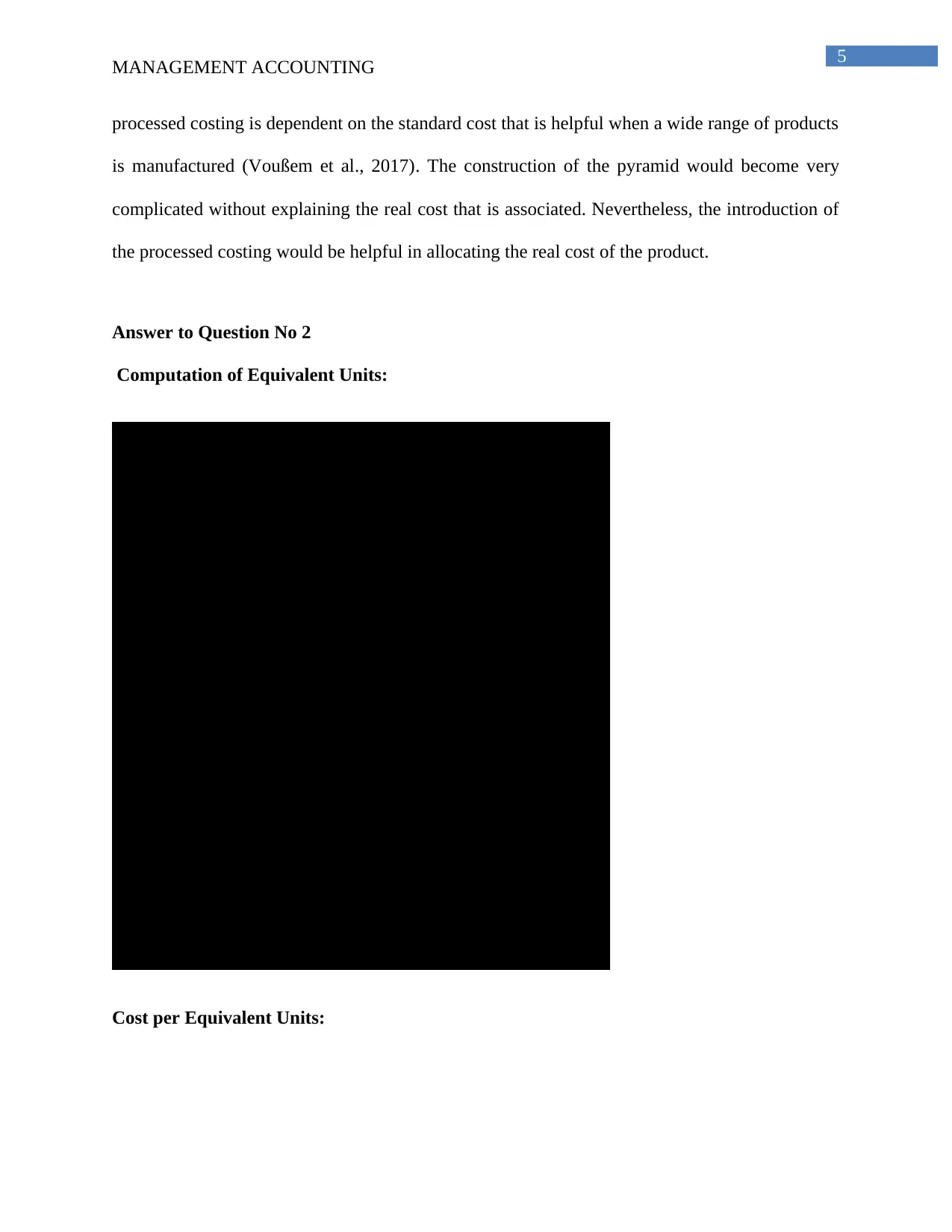
5
MANAGEMENT ACCOUNTING
processed costing is dependent on the standard cost that is helpful when a wide range of products
is manufactured (Voußem et al., 2017). The construction of the pyramid would become very
complicated without explaining the real cost that is associated. Nevertheless, the introduction of
the processed costing would be helpful in allocating the real cost of the product.
Answer to Question No 2
Computation of Equivalent Units:
Process 1 Physical Flow
Material Conversion
O/WIP 2000 0 1400
Started in May 6000
Total Production 8000
Completed in Process 7000 7000 7000
C/WIP 1000 1000 500
Total Equivalent Units 8000 7500
Process 2 Physical Flow
Material Conversion
O/WIP 1000 0 500
Started in May 7000
Total Production 8000
C/WIP 750 0 225
Completed I Process 7250 7250 7250
Total Equivalent Units 7250 7975
Equivalent Units
Equivalent Units
Cost per Equivalent Units:
MANAGEMENT ACCOUNTING
processed costing is dependent on the standard cost that is helpful when a wide range of products
is manufactured (Voußem et al., 2017). The construction of the pyramid would become very
complicated without explaining the real cost that is associated. Nevertheless, the introduction of
the processed costing would be helpful in allocating the real cost of the product.
Answer to Question No 2
Computation of Equivalent Units:
Process 1 Physical Flow
Material Conversion
O/WIP 2000 0 1400
Started in May 6000
Total Production 8000
Completed in Process 7000 7000 7000
C/WIP 1000 1000 500
Total Equivalent Units 8000 7500
Process 2 Physical Flow
Material Conversion
O/WIP 1000 0 500
Started in May 7000
Total Production 8000
C/WIP 750 0 225
Completed I Process 7250 7250 7250
Total Equivalent Units 7250 7975
Equivalent Units
Equivalent Units
Cost per Equivalent Units:
⊘ This is a preview!⊘
Do you want full access?
Subscribe today to unlock all pages.

Trusted by 1+ million students worldwide
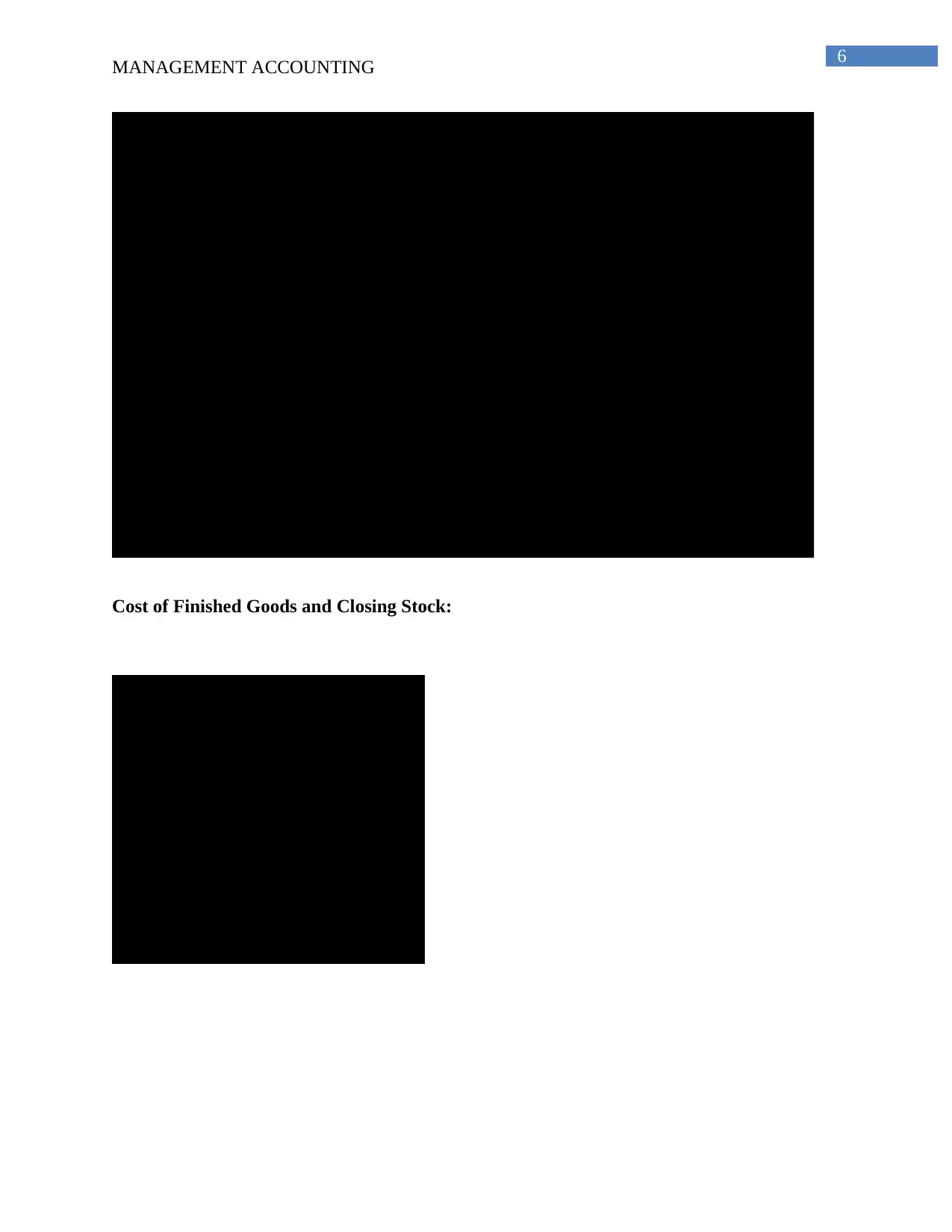
6
MANAGEMENT ACCOUNTING
Particulars Material Coversion Transferred-in Total
Process 1:
O/WIP Cost $3,000 $2,000 $5,000
Current Cost $30,000 $60,000 $90,000
Total Production Cost of Process 1 $33,000 $62,000 $95,000
Total Equivalent Units 8000 7500
Cost per Equivalent Units of Process 1 $4.13 $8.27 $12.39
Process 2:
O/WIP Cost $3,000 $4,000 $8,000 $15,000
Current Cost $35,000 $45,000 $86,742 $166,742
Total Production Cost of Process 2 $38,000 $49,000 $94,742 $181,742
Total Equivalent Units 7250 7975 7000
Cost per Equivalent Units of Process 2 $5.24 $6.14 $13.53 $25
Cost of Finished Goods and Closing Stock:
Particulars Amount
Finished Goods Completed during May 7250
Cost per Equivalent Units $25
Cost of Finished Goods Completed $180,671
Closing Stock in Process 1 1000
Cost per Equivalent Units for Process 1 $12.39
Cost of Closing Stock in Process 1 $12,391.67
Closing Stock in Process 2 750
Cost per Equivalent Units for Process 1 $24.92
Cost of Closing Stock in Process 2 $18,690.08
MANAGEMENT ACCOUNTING
Particulars Material Coversion Transferred-in Total
Process 1:
O/WIP Cost $3,000 $2,000 $5,000
Current Cost $30,000 $60,000 $90,000
Total Production Cost of Process 1 $33,000 $62,000 $95,000
Total Equivalent Units 8000 7500
Cost per Equivalent Units of Process 1 $4.13 $8.27 $12.39
Process 2:
O/WIP Cost $3,000 $4,000 $8,000 $15,000
Current Cost $35,000 $45,000 $86,742 $166,742
Total Production Cost of Process 2 $38,000 $49,000 $94,742 $181,742
Total Equivalent Units 7250 7975 7000
Cost per Equivalent Units of Process 2 $5.24 $6.14 $13.53 $25
Cost of Finished Goods and Closing Stock:
Particulars Amount
Finished Goods Completed during May 7250
Cost per Equivalent Units $25
Cost of Finished Goods Completed $180,671
Closing Stock in Process 1 1000
Cost per Equivalent Units for Process 1 $12.39
Cost of Closing Stock in Process 1 $12,391.67
Closing Stock in Process 2 750
Cost per Equivalent Units for Process 1 $24.92
Cost of Closing Stock in Process 2 $18,690.08
Paraphrase This Document
Need a fresh take? Get an instant paraphrase of this document with our AI Paraphraser
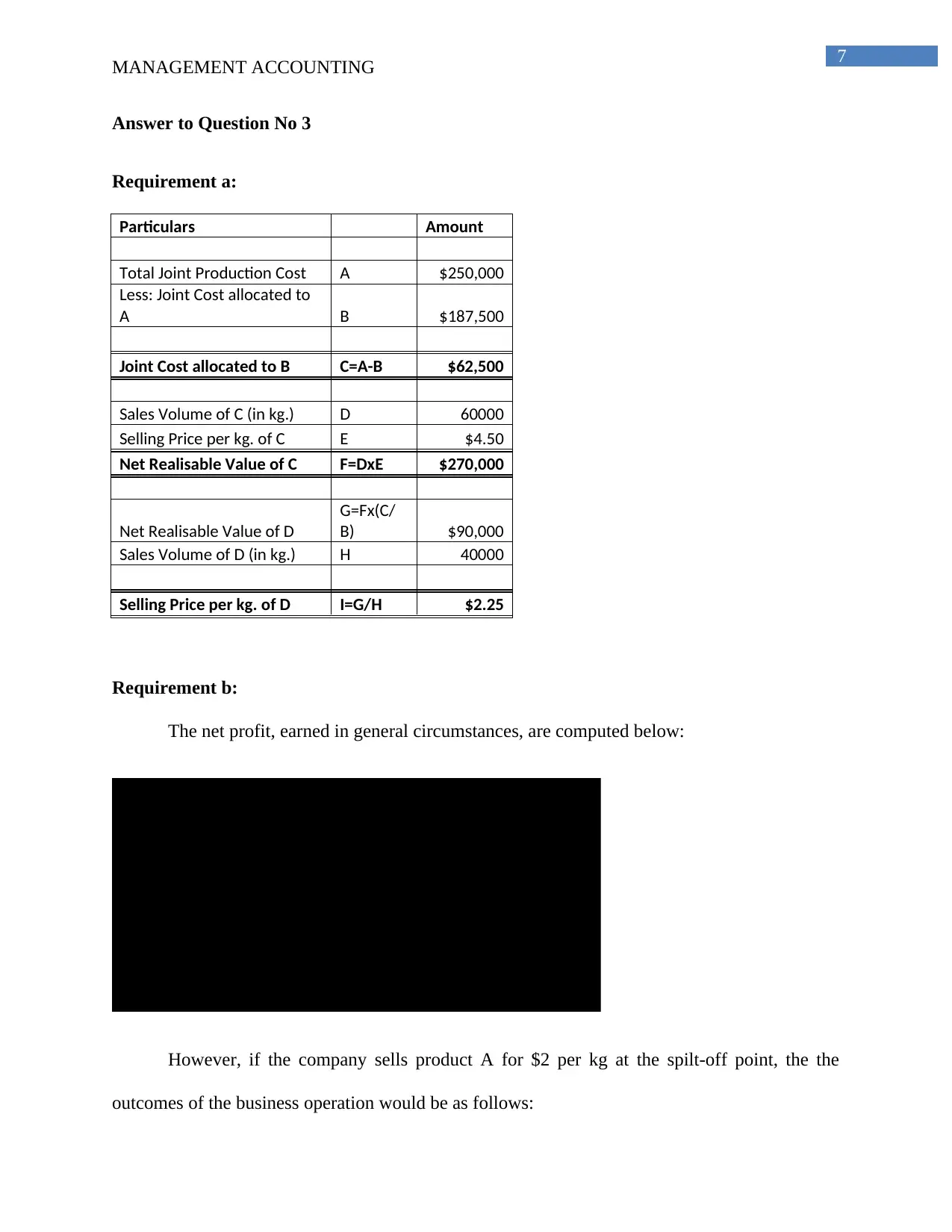
7
MANAGEMENT ACCOUNTING
Answer to Question No 3
Requirement a:
Particulars Amount
Total Joint Production Cost A $250,000
Less: Joint Cost allocated to
A B $187,500
Joint Cost allocated to B C=A-B $62,500
Sales Volume of C (in kg.) D 60000
Selling Price per kg. of C E $4.50
Net Realisable Value of C F=DxE $270,000
Net Realisable Value of D
G=Fx(C/
B) $90,000
Sales Volume of D (in kg.) H 40000
Selling Price per kg. of D I=G/H $2.25
Requirement b:
The net profit, earned in general circumstances, are computed below:
Particulars A B Total
Selling Price per unit $4.50 $2.25
Sales Volume 60000 40000 100000
Total Sale Revenue $270,000 $90,000 $360,000
Joint Cost Allocation ($187,500) ($62,500) ($250,000)
Further Processing Cost ($45,000) ($25,000) ($70,000)
Net Profit $37,500 $2,500 $40,000
However, if the company sells product A for $2 per kg at the spilt-off point, the the
outcomes of the business operation would be as follows:
MANAGEMENT ACCOUNTING
Answer to Question No 3
Requirement a:
Particulars Amount
Total Joint Production Cost A $250,000
Less: Joint Cost allocated to
A B $187,500
Joint Cost allocated to B C=A-B $62,500
Sales Volume of C (in kg.) D 60000
Selling Price per kg. of C E $4.50
Net Realisable Value of C F=DxE $270,000
Net Realisable Value of D
G=Fx(C/
B) $90,000
Sales Volume of D (in kg.) H 40000
Selling Price per kg. of D I=G/H $2.25
Requirement b:
The net profit, earned in general circumstances, are computed below:
Particulars A B Total
Selling Price per unit $4.50 $2.25
Sales Volume 60000 40000 100000
Total Sale Revenue $270,000 $90,000 $360,000
Joint Cost Allocation ($187,500) ($62,500) ($250,000)
Further Processing Cost ($45,000) ($25,000) ($70,000)
Net Profit $37,500 $2,500 $40,000
However, if the company sells product A for $2 per kg at the spilt-off point, the the
outcomes of the business operation would be as follows:
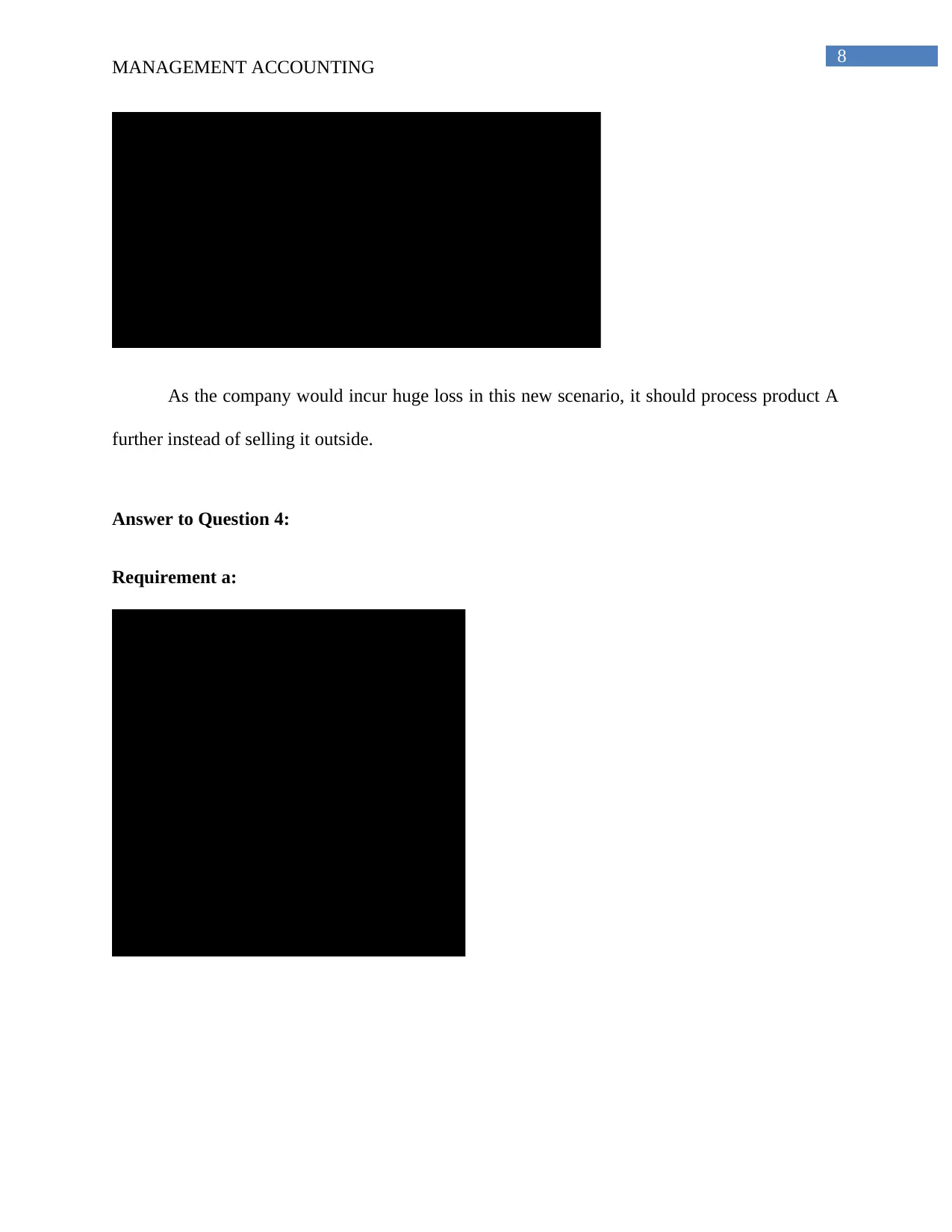
8
MANAGEMENT ACCOUNTING
Particulars A B Total
Selling Price per unit $2.00 $2.25
Sales Volume 60000 40000 100000
Total Sale Revenue $120,000 $90,000 $210,000
Joint Cost Allocation ($142,857) ($107,143) ($250,000)
Further Processing Cost ($25,000) ($25,000)
Net Profit ($22,857) ($42,143) ($65,000)
As the company would incur huge loss in this new scenario, it should process product A
further instead of selling it outside.
Answer to Question 4:
Requirement a:
Particulars Amount
Material Purchased (in units) 220000
Standard Price per kg $6
Standard Cost for Actual Material
Purchased $1,320,000
Actual Cost of Actual Material
Purchased $1,364,000
Material Price Variance ($44,000)
Remarks Unfavorable
Material Price Variance:
MANAGEMENT ACCOUNTING
Particulars A B Total
Selling Price per unit $2.00 $2.25
Sales Volume 60000 40000 100000
Total Sale Revenue $120,000 $90,000 $210,000
Joint Cost Allocation ($142,857) ($107,143) ($250,000)
Further Processing Cost ($25,000) ($25,000)
Net Profit ($22,857) ($42,143) ($65,000)
As the company would incur huge loss in this new scenario, it should process product A
further instead of selling it outside.
Answer to Question 4:
Requirement a:
Particulars Amount
Material Purchased (in units) 220000
Standard Price per kg $6
Standard Cost for Actual Material
Purchased $1,320,000
Actual Cost of Actual Material
Purchased $1,364,000
Material Price Variance ($44,000)
Remarks Unfavorable
Material Price Variance:
⊘ This is a preview!⊘
Do you want full access?
Subscribe today to unlock all pages.

Trusted by 1+ million students worldwide
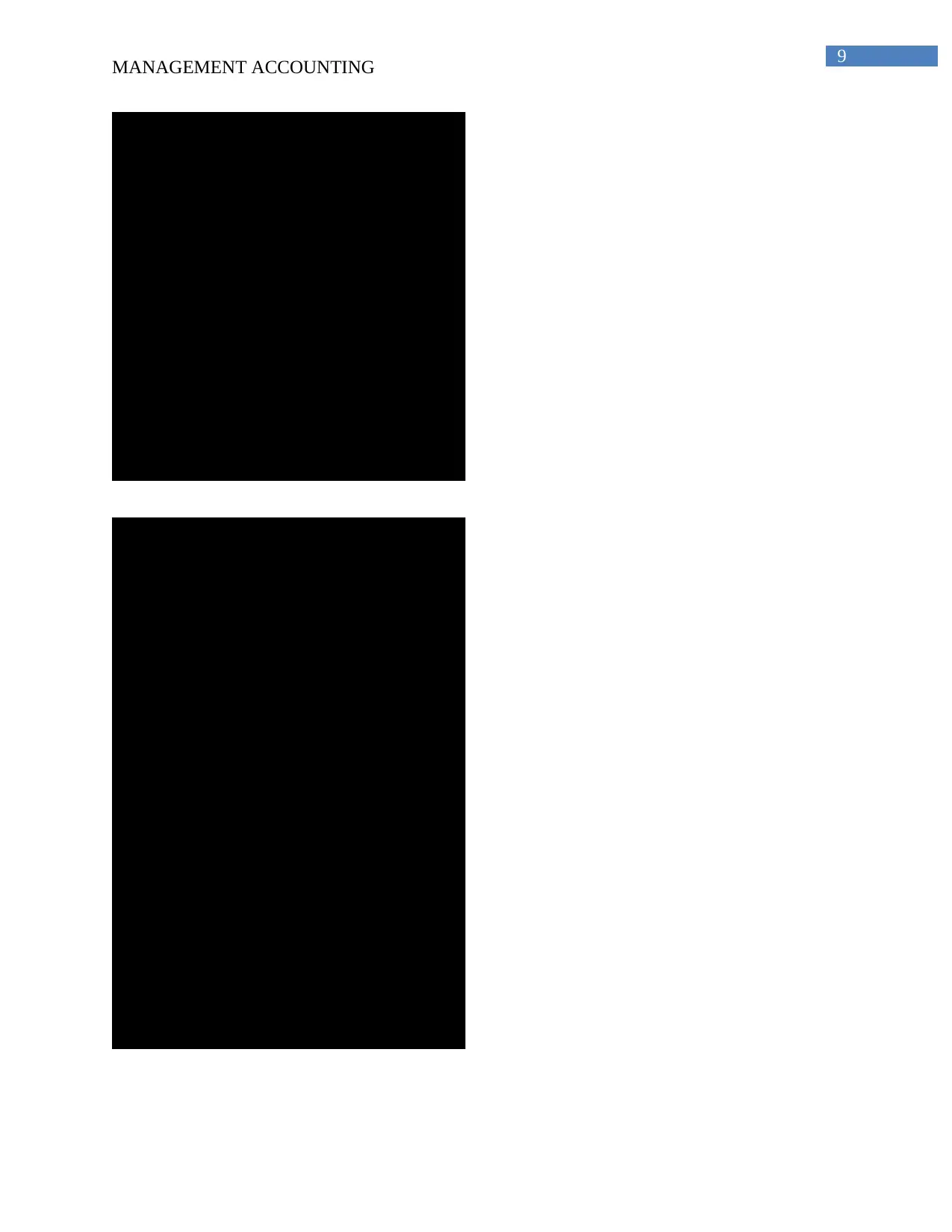
9
MANAGEMENT ACCOUNTING
Particulars Amount
Units Produced 19500
Standard Usage per unit of
production 11
Standard Usage for Actual
Production 214500
Actual Material Usage 197000
Standard price per kg. $6
Material Usage Variance $105,000
Remarks Favorable
Material Usage Variance:
Particulars Amount
Actual Production 19500
Standard Labor hour per unit 2
Standard Labor Hour for Actual
Production 39000
Actual Labor Hours 40000
Standard Labor Rate per hour $20
Direct Labor Efficiency Variance ($20,000)
Total Direct Labor Variance ($1,650)
Direct Labor Rate Variace $18,350
Standard Labor Cost for Actual
Labor Hours $800,000
Actual Labor Cost $781,650
Actual Direct Labor Rate per hour $19.54
Actual Direct Labor Rate per hour:
MANAGEMENT ACCOUNTING
Particulars Amount
Units Produced 19500
Standard Usage per unit of
production 11
Standard Usage for Actual
Production 214500
Actual Material Usage 197000
Standard price per kg. $6
Material Usage Variance $105,000
Remarks Favorable
Material Usage Variance:
Particulars Amount
Actual Production 19500
Standard Labor hour per unit 2
Standard Labor Hour for Actual
Production 39000
Actual Labor Hours 40000
Standard Labor Rate per hour $20
Direct Labor Efficiency Variance ($20,000)
Total Direct Labor Variance ($1,650)
Direct Labor Rate Variace $18,350
Standard Labor Cost for Actual
Labor Hours $800,000
Actual Labor Cost $781,650
Actual Direct Labor Rate per hour $19.54
Actual Direct Labor Rate per hour:
Paraphrase This Document
Need a fresh take? Get an instant paraphrase of this document with our AI Paraphraser
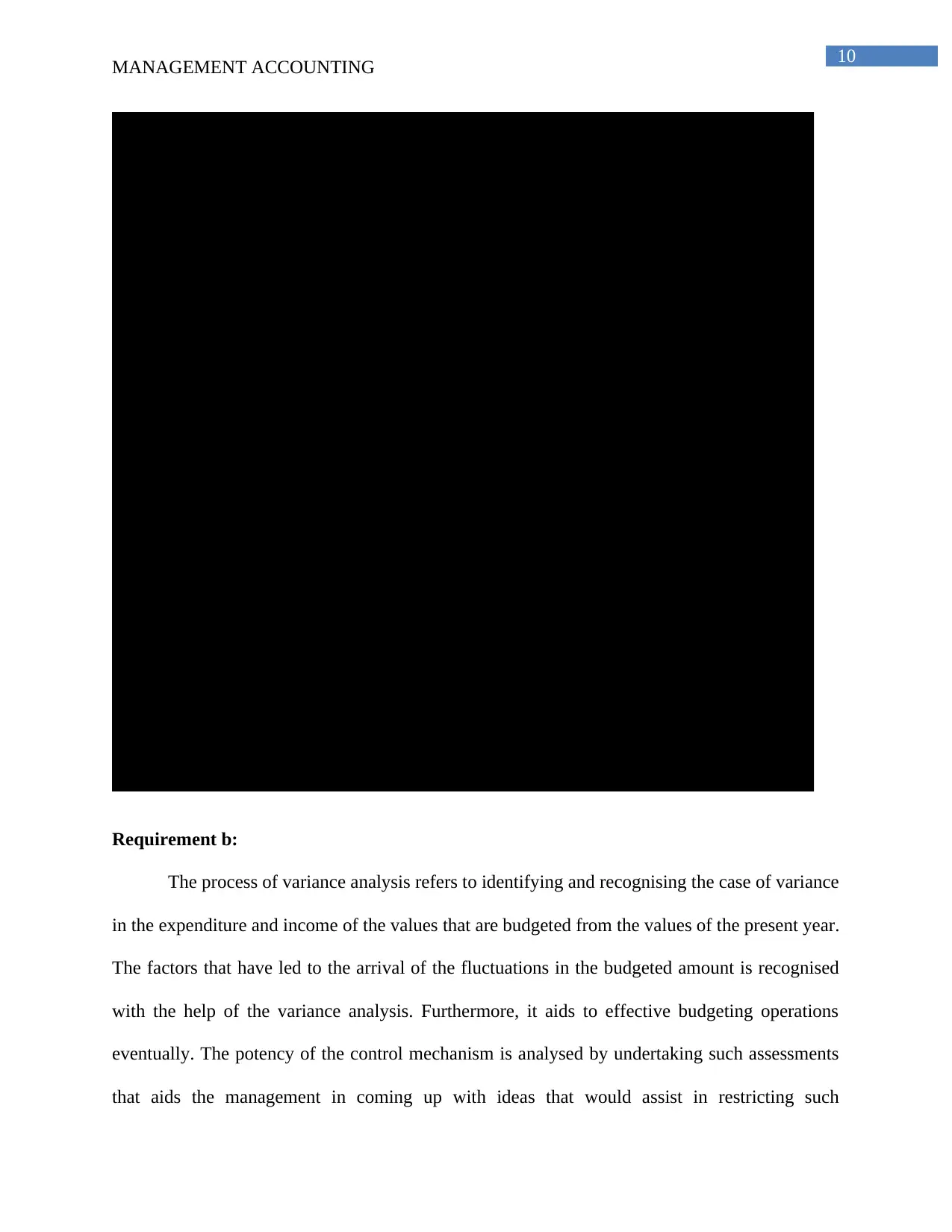
10
MANAGEMENT ACCOUNTING
Dr. Cr.
Date Amount Amount
Direct Material A/c. Dr. $1,364,000
To, Accounts Payable A/c. $1,364,000
Work-in-Progress A/c. Dr. 1287000
To, Direct Material A/c. 1287000
Material Price Variance A/c. Dr. $44,000
To, Direct Material A/c. $44,000
Direct Material A/c. Dr. $105,000
To, Material Usage Variance A/c. $105,000
Direct Labor Cost A/c. Dr. $781,650
To, Accrued Payroll A/c. $781,650
Work-in-Progress A/c. Dr. 780000
To, Direct Labor Cost A/c. 780000
Direct Labor Cost A/c. Dr. $18,350
To, Direct Labor Rate Variance A/c. $18,350
Direct Labor Efficiency Variance A/c. Dr. $20,000
To, Direct Labor Cost A/c. $20,000
Material Usage Variance A/c. Dr. $105,000
Direct Labor Rate Variance A/c. Dr. $18,350
To, Cost of Goods Sold A/c. $59,350
To, Direct Labor Efficiency Variance A/c. $20,000
To, Material Price Variance A/c. $44,000
Particulars
Requirement b:
The process of variance analysis refers to identifying and recognising the case of variance
in the expenditure and income of the values that are budgeted from the values of the present year.
The factors that have led to the arrival of the fluctuations in the budgeted amount is recognised
with the help of the variance analysis. Furthermore, it aids to effective budgeting operations
eventually. The potency of the control mechanism is analysed by undertaking such assessments
that aids the management in coming up with ideas that would assist in restricting such
MANAGEMENT ACCOUNTING
Dr. Cr.
Date Amount Amount
Direct Material A/c. Dr. $1,364,000
To, Accounts Payable A/c. $1,364,000
Work-in-Progress A/c. Dr. 1287000
To, Direct Material A/c. 1287000
Material Price Variance A/c. Dr. $44,000
To, Direct Material A/c. $44,000
Direct Material A/c. Dr. $105,000
To, Material Usage Variance A/c. $105,000
Direct Labor Cost A/c. Dr. $781,650
To, Accrued Payroll A/c. $781,650
Work-in-Progress A/c. Dr. 780000
To, Direct Labor Cost A/c. 780000
Direct Labor Cost A/c. Dr. $18,350
To, Direct Labor Rate Variance A/c. $18,350
Direct Labor Efficiency Variance A/c. Dr. $20,000
To, Direct Labor Cost A/c. $20,000
Material Usage Variance A/c. Dr. $105,000
Direct Labor Rate Variance A/c. Dr. $18,350
To, Cost of Goods Sold A/c. $59,350
To, Direct Labor Efficiency Variance A/c. $20,000
To, Material Price Variance A/c. $44,000
Particulars
Requirement b:
The process of variance analysis refers to identifying and recognising the case of variance
in the expenditure and income of the values that are budgeted from the values of the present year.
The factors that have led to the arrival of the fluctuations in the budgeted amount is recognised
with the help of the variance analysis. Furthermore, it aids to effective budgeting operations
eventually. The potency of the control mechanism is analysed by undertaking such assessments
that aids the management in coming up with ideas that would assist in restricting such
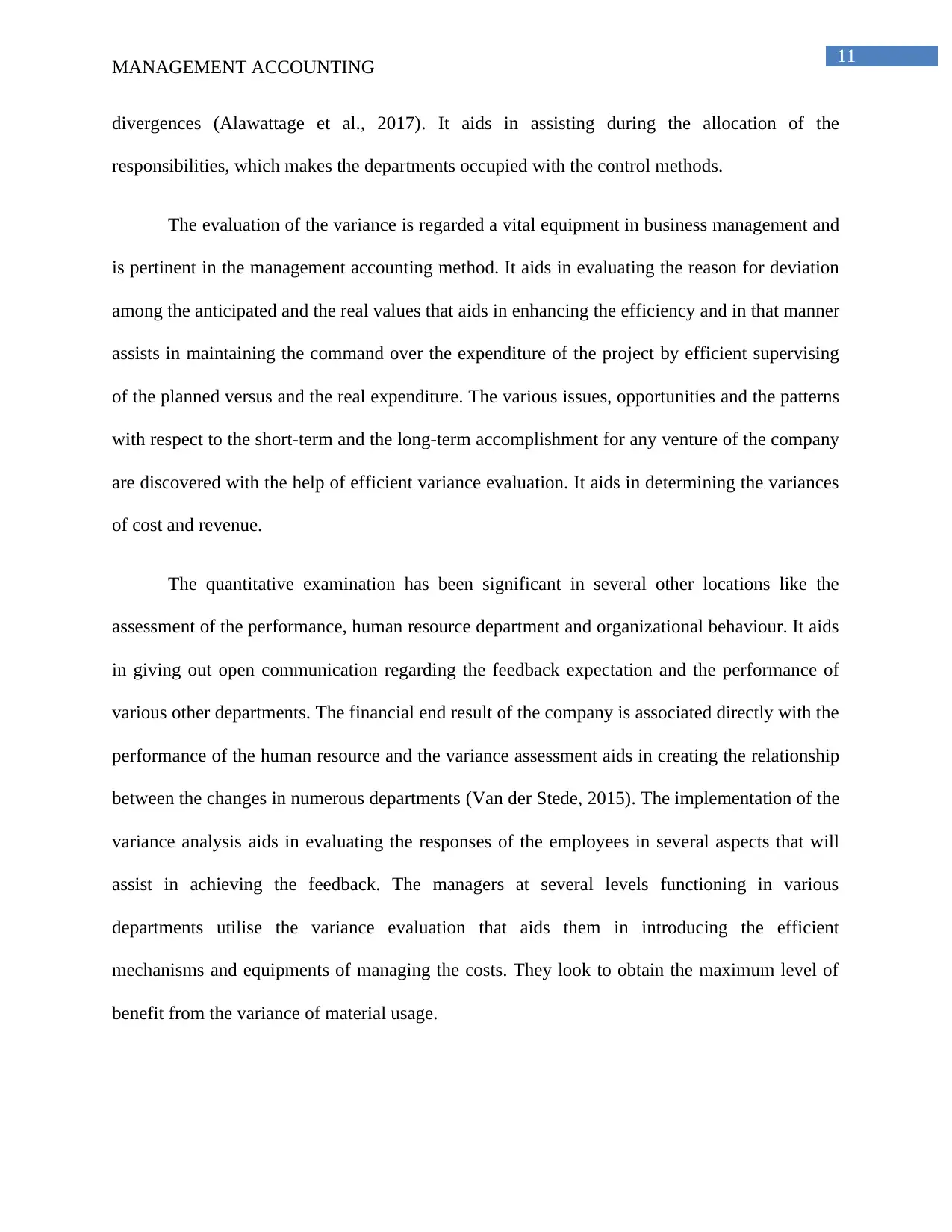
11
MANAGEMENT ACCOUNTING
divergences (Alawattage et al., 2017). It aids in assisting during the allocation of the
responsibilities, which makes the departments occupied with the control methods.
The evaluation of the variance is regarded a vital equipment in business management and
is pertinent in the management accounting method. It aids in evaluating the reason for deviation
among the anticipated and the real values that aids in enhancing the efficiency and in that manner
assists in maintaining the command over the expenditure of the project by efficient supervising
of the planned versus and the real expenditure. The various issues, opportunities and the patterns
with respect to the short-term and the long-term accomplishment for any venture of the company
are discovered with the help of efficient variance evaluation. It aids in determining the variances
of cost and revenue.
The quantitative examination has been significant in several other locations like the
assessment of the performance, human resource department and organizational behaviour. It aids
in giving out open communication regarding the feedback expectation and the performance of
various other departments. The financial end result of the company is associated directly with the
performance of the human resource and the variance assessment aids in creating the relationship
between the changes in numerous departments (Van der Stede, 2015). The implementation of the
variance analysis aids in evaluating the responses of the employees in several aspects that will
assist in achieving the feedback. The managers at several levels functioning in various
departments utilise the variance evaluation that aids them in introducing the efficient
mechanisms and equipments of managing the costs. They look to obtain the maximum level of
benefit from the variance of material usage.
MANAGEMENT ACCOUNTING
divergences (Alawattage et al., 2017). It aids in assisting during the allocation of the
responsibilities, which makes the departments occupied with the control methods.
The evaluation of the variance is regarded a vital equipment in business management and
is pertinent in the management accounting method. It aids in evaluating the reason for deviation
among the anticipated and the real values that aids in enhancing the efficiency and in that manner
assists in maintaining the command over the expenditure of the project by efficient supervising
of the planned versus and the real expenditure. The various issues, opportunities and the patterns
with respect to the short-term and the long-term accomplishment for any venture of the company
are discovered with the help of efficient variance evaluation. It aids in determining the variances
of cost and revenue.
The quantitative examination has been significant in several other locations like the
assessment of the performance, human resource department and organizational behaviour. It aids
in giving out open communication regarding the feedback expectation and the performance of
various other departments. The financial end result of the company is associated directly with the
performance of the human resource and the variance assessment aids in creating the relationship
between the changes in numerous departments (Van der Stede, 2015). The implementation of the
variance analysis aids in evaluating the responses of the employees in several aspects that will
assist in achieving the feedback. The managers at several levels functioning in various
departments utilise the variance evaluation that aids them in introducing the efficient
mechanisms and equipments of managing the costs. They look to obtain the maximum level of
benefit from the variance of material usage.
⊘ This is a preview!⊘
Do you want full access?
Subscribe today to unlock all pages.

Trusted by 1+ million students worldwide
1 out of 16
Related Documents
Your All-in-One AI-Powered Toolkit for Academic Success.
+13062052269
info@desklib.com
Available 24*7 on WhatsApp / Email
![[object Object]](/_next/static/media/star-bottom.7253800d.svg)
Unlock your academic potential
Copyright © 2020–2025 A2Z Services. All Rights Reserved. Developed and managed by ZUCOL.





